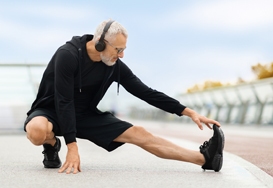Arthritis can take many forms, but the most commonly diagnosed is osteoarthritis (OA). (1) Caused by the gradual breakdown of cartilage in almost any joint it can result in arthritis related pain, stiffness, decreased range of motion, a feeling of grating in the affected joint, and point tenderness. Worldwide, millions of people are affected by OA; in the US almost 27 million people live with its effects. Osteoarthritis does not discriminate based on race or ethnicity however it is most common in people under 45. Men are typically affected more than women when they are under 55 years old, but after the age of 55 that changes to women being more likely to feel the discomfort of osteoarthritis. (2)
Risk Factors For Osteoarthritis
A few OA risk factors you cannot avoid are:
- Genetics – Joints that are misshapen and have a family history of osteoarthritis
- Prior Joint Problems – Previous joint injuries, surgical procedures, infections and a history of other types of arthritis
- Buildup Of Elements – An overabundance of calcium, iron, or copper due to endocrine or metabolic issues
- Nerve Damage – Poorly functioning nerves can lead to changes in your posture, which in turn can cause joint damage
- Age – As years pass, wear and tear on the joints increases
- You can decrease some of the risks, including:
- Physical Activity – A lack of exercise causing weak muscles and stiff joints
- Weight – The more pressure put on the joints, the more damage is done
- Injury – Major injuries can seriously damage the joint’s cartilage
- Repetitive Motions – An activity that requires a motion to consistently be repeated will wear the cartilage down much quicker
Things You Can Do To Prevent Osteoarthritis
The only real way to prevent osteoarthritis is by protecting the cartilage in the joints. Knowing the risk factors that you control makes prevention much easier. The specific steps to reducing your chances of feeling the pain of osteoarthritis are:
- Regular Exercise – No matter the intensity of physical activity it is always best to get some exercise. Most physicians think that every week you should spend 30 minutes working out on five different days.
- Decreased Weight – The exercise mentioned above, coupled with a healthy diet can get you down to an ideal body weight. If you are 10 pounds overweight you can be placing the equivalent of 60 pounds of pressure on your knees and 30 pounds on your hips. (3)
- Reduce Repeat Motions – When possible, avoid jobs or activities that force you to make the same motion repeatedly. If you can’t avoid it make sure you take breaks to do things to reduce the stress placed on the joints.
- Injury Prevention – No one can completely prevent injuries. Accidents do happen, but avoiding sports and activities that have the potential for injury reduce your chances. It is especially important in the northern states to watch for ice in the winter months.
- Learn Proper Joint Mechanics – There are good and bad ways to move your joints. Pay attention to your posture and how you accomplish your tasks. Typically, moving in a manner that is smooth and conserves your energy is best.
- Stop If It Hurts – Pain is your body’s signal that something is going wrong. If you feel pain and push yourself past it you have the potential to do serious harm to your body and joints.
Sometimes developing osteoarthritis in unavoidable, despite following the best practices for protecting your joints. Some people are unlucky with their genes and others are unlucky with injuries. Either way, if you start to feel the symptoms of OA it is important to seek the help of a rheumatologist. The physicians at the Illinois Bone and Joint Institute are some of the finest and most experienced orthopedic and rheumatic disease doctors in the Midwest. In fact, every year the physicians at IBJI treat 44,000 arthritis patients, which give them an amazing amount of experience to call on in helping you get relief from your pain and stiffness. Schedule online today to get your symptoms diagnosed and your pain managed effectively. IBJI is your best choice for the treatment and relief of osteoarthritis pain and discomfort.
Sources
- https://www.mayoclinic.com/health/osteoarthritis/DS00019
- https://www.arthritis.org/disease-center.php?disease_id=32&df=whos_at_risk
- https://www.ncbi.nlm.nih.gov/pubmed/17350544
*This content is for information only and is not intended to replace the diagnosis, treatment, or medical advice from your treating healthcare professionals. The content does not provide medical advice, does not constitute the practice of medicine or other healthcare professional services, and does not create a doctor-patient relationship. You should not rely on this information as a substitute, nor does it replace professional medical advice, diagnosis, or treatment. If you have concerns or questions, seek the advice of your healthcare professionals. If you think you may have a medical emergency, call your doctor or 911 immediately. Do not rely on electronic communications or communicate through this website for immediate, urgent medical needs. This website is not designed to facilitate medical emergencies. The use of the information is at the reader’s own risk. The links are provided for information and convenience only. We cannot accept responsibility for the sites linked or the information found here. A link does not imply an endorsement of a site.




